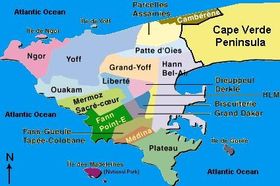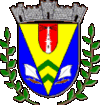Dakar
2007 Schools Wikipedia Selection. Related subjects: African Geography
|
|||
 |
|||
| (City of Dakar, divided into 19 communes d'arrondissement) | |||
| City proper ( commune) |
|||
|---|---|---|---|
| Région | Dakar | ||
| Département | Dakar | ||
| Mayor | Pape Diop ( PDS) (since 2002) |
||
| Area | 82.5 km² | ||
| Subdivisions | 19 communes d'arrondiss. | ||
| Population 31.12.2004 estimate |
(Ranked 1st) 1,009,256 |
||
| Density | 12,233/km² | ||
| Metropolitan area ( Dakar région) |
|||
| (data here are for the administrative Dakar région, which matches almost exactly the limits of the metropolitan area) | |||
| Regional president | Abdoulaye Faye ( PDS) (since 2002) |
||
| Communes | 7 (as of Dec. 2004), plus 2 communautés rurales |
||
| Area | 547 km² | ||
| Population 31.12.2004 estimate |
(Ranked 1st) 2,399,451 |
||
| Yearly growth | approx. +2.50 % | ||
| Density | 4,387/km² | ||
| Miscellaneous | |||
| Sister cities | Washington, D.C. (USA) Taipei (Taiwan) Sfax (Tunisia) Praia (Cape Verde) Oran (Algeria) Niamey (Niger) Milan (Italy) Marseille (France) Kinshasa (D. Rep. Congo) (Palestine) Douala (Cameroon) Casablanca (Morocco) Brazzaville (Rep. Congo) Bissau (Guinea-Bissau) Banjul (Gambia) Bamako (Mali) Baku (Azerbaijan) |
||
Dakar is the capital city of Senegal, located on the Cape Verde Peninsula, on the country's Atlantic coast. Its position, on the western edge of Africa (it is the westernmost African city), is an advantageous departure point for trans-Atlantic and European trade; this fact aided its growth into a major regional port.
In 2005 the population of the metropolitan area was estimated at 2.4 million people, of which about 1 million live in the city of Dakar proper.
Dakar is a major administrative centre, home to the Senegal National Assembly and Senegal Presidential Palace.
Geography
Dakar is located at 14°40'20" North, 17°25'22" West (14.67222, -17.422778).
History
The traditional date of the founding of Yoff, headquarters of the Layene Sufi order in northern Dakar, is 1430. Meanwhile, in 1444, the Portuguese arrived on the island of Gorée, founding a settlement there, and by 1536, had begun using it as a base for the export of slaves. By this time, the mainland of Cap-Vert, including Yoff, was under control of the Jolof Empire, as part of the western province of Cayor — which seceded from Jolof in its own right in 1549.
Gorée was captured by the United Netherlands in 1588, who gave it its present name (spelled Goeree, after Goeree-Overflakkee in Holland). The island was to switch hands between the Portuguese and Dutch a couple more times before falling to the English under Admiral Holmes on 23 January 1664, and finally to the French in 1677. Though under continuous French administration after that, both Dutch and French families dominated the slave trade, and the infamous " House of Slaves" was built here in 1776. The slave trade was abolished by France in February 1794. However, Napoleon reinstated it in May 1802, then finally abolished it permanently in March 1815.
In 1812, the political independence of the Layene at Yoff was recognised by the Kingdom of Cayor, a sort of 'theocratic autonomy' that they enjoy to this day.
Despite Napoleon's abolition, a clandestine slave trade continued at Gorée until 1848, when it was abolished throughout all French territories. Nevertheless, the island's population grew to 6000 residents, and when the city of Dakar was formed around a French fort in 1857, most of these moved to the mainland. Under the French governor, Louis Faidherbe, the French began to expand their control over the region at the expense of Cayor.
Gorée, including Dakar, was recognised as a French commune in 1872. The settlement grew as a port and railway hub, the latter opening in 1885 with a route to Saint-Louis; this train is now only used for special excursions. Dakar itself was split off from Gorée as a separate commune in 1887.
The city later became a naval base, and replaced Saint-Louis as the capital of French West Africa in 1902. In 1929, the commune of Gorée Island, now with only a few hundred inhabitants, was merged into Dakar. The Battle of Dakar took place off the coast of Dakar on September 23 - September 25, 1940.
Dakar was the capital of the short-lived Mali Federation from 1959 to 1960, after which it became the capital of Senegal.
The Fort D'Estrees on Gorée Island, where slaves were held, auctioned, and packed onto ships, was restored by the Senegalese government in the 20th century and transformed into a museum.
Administration
The city of Dakar is a commune, (also sometimes known as commune de ville), one of the 67 communes of Senegal. The commune of Dakar was created by the French colonial administration on June 17, 1887 by detaching it from the commune of Gorée. The commune of Gorée, created in 1872, was itself one of the oldest western-style municipalities in Africa (along with the municipalities of Algeria and South Africa).
The commune of Dakar has been in continuous existence since 1887, being preserved by the new state of Senegal after independence in 1960, although its limits have varied considerably over time. The limits of the commune of Dakar have been unchanged since 1983. The commune of Dakar is ruled by a democratically elected municipal council (conseil municipal) serving five years, and a mayor elected by the municipal council. There have been 20 mayors in Dakar since 1887. The first Black mayor was Blaise Diagne, mayor of Dakar from 1924 to 1934. The longest serving mayor was Mamadou Diop, mayor for 18 years between 1984 and 2002.
The commune of Dakar is also a département, one of the 34 départements of Senegal. This situation is quite similar to Paris in France which is both a commune and a département. However, contrary to French départements, départements in Senegal have no political power (no departmental assembly), and are merely local administrative structures of the central state, in charge of carrying out some administrative services as well as controlling the activities of the communes within the département.
The département of Dakar is divided into four arrondissements: Almadies, Grand Dakar, Parcelles Assanies (which literally means "drained lots"; this is the most populated arrondissement of Dakar), and Plateau/Gorée (downtown Dakar). These arrondissements are quite different from the arrondissements of Paris, being merely local administrative structures of the central state, like the Senegalese départements, and are thus more comparable to French departmental arrondissements.
In 1996, a massive reform of the administrative and political divisions of Senegal was voted by the Parliament of Senegal. The commune of Dakar, whose population approached 1 million inhabitants, was deemed too large and too populated to be properly managed by a central municipality, and so on August 30, 1996 Dakar was divided into 19 communes d'arrondissement.
These communes d'arrondissement were given extensive powers, and are very much like regular communes. They have more powers than the arrondissements of Paris, and are more akin to the London boroughs. The commune of Dakar was maintained above these 19 communes d'arrondissement, and it coordinates the activities of the communes d'arrondissement, much as Greater London coordinates the activities of the London boroughs.
The 19 communes d'arrondissement belong to either of the four arrondissements of Dakar, and the sous-préfet of each arrondissement is in charge of controlling the activities of the communes d'arrondissement in his arrondissement.
The commune d'arrondissement of Dakar-Plateau (34,626 inhabitants), in the arrondissement of Plateau/Gorée, is the historical heart of the city, and most ministries and public administrations are located there. The densest and most populated commune d'arrondissement is Médina (136,697 inhabitants), in the arrondissement of Plateau/Gorée. The commune d'arrondissement of Yoff (55,995 inhabitants), in the arrondissement of Almadies, is the largest one, while the smallest one is the commune d'arrondissement of Île de Gorée (1,034 inhabitants), in the arrondissement of Plateau/Gorée.
The département of Dakar is one of the four départements of the Dakar région, which is one of the 11 régions of Senegal. The Dakar région encompasses the city of Dakar and all its suburbs along the Cape Verde Peninsula. Its territory is thus roughly the same as the territory of the metropolitan area of Dakar. Since the administrative reforms of 1996, the régions of Senegal, which until then were merely local administrative structures of the central state, have been turned into full-fledged political units, with democratically elected regional councils, and regional presidents. They were given extensive powers, and manage economic development, transportation, or environmental protection issues at the regional level, thus coordinating the actions of the communes below them.
Following the political transition of 2000 when Abdoulaye Wade, leader of the opposition ( Senegalese Democratic Party, or PDS), defeated President Abdou Diouf ( Socialist Party of Senegal), local elections were held in 2002. Two leaders of the PDS, Pape Diop and Abdoulaye Faye, ambitioned to become mayor of Dakar. Eventually, a compromise was found: Pape Diop would run for the municipal election of Dakar, while Abdoulaye Faye would run for the regional election of Dakar. The local elections of Senegal were held on May 12, 2002, and saw the PDS largely defeating the Socialists. Pape Diop was elected mayor of Dakar, defeating the long time Socialist mayor Mamadou Diop, while Abdoulaye Faye was elected president of the regional council of the Dakar région, defeating the Socialists who hitherto controlled the région.
Sights
Attractions in Dakar include major markets, Dakar Grand Mosque (built in 1964), Gorée Island, the IFAN Museum of West African culture, clifftop walks and beaches, and Hann Park, home to Senegal Zoo.
Transportation
The town serves as a port and is home to the Léopold Sédar Senghor International Airport. It is also the terminus of the Dakar-Niger railroad line.
Notable Residents
Aliaune "Akon" Thiam, R&B Singer
Sister cities
 Washington, DC, USA
Washington, DC, USA Ann Arbor, Michigan, USA
Ann Arbor, Michigan, USA

